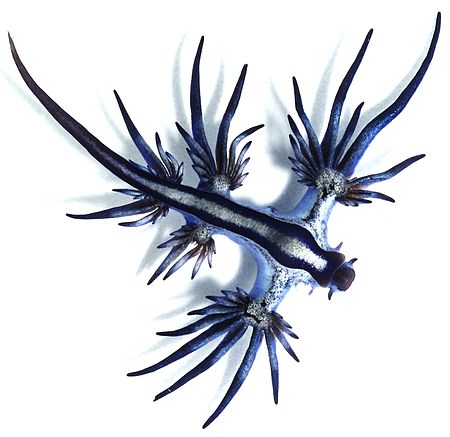Template:Species-2013-02-2
Species of the month[edit]
Blue Glaucus[edit]
Some facts on this sea slug:
Size: Between 3 and 5 cm.
Habitat: Floats upside down on the surface tension of the ocean.
Range: Distributed throughout the world's oceans, in temperate and tropical waters.
Diet: Siphonophores (jellyfish-like creatures).
Reproduction: Hermaphroditic creature, possessing both male and female reproductive organs.
First described: By the German-Polish naturalist, ethnologist, travel writer, journalist, and revolutionary Georg Forster in 1777.
Glaucus atlanticus has a tough stomach indeed. This sea slug's diet consists of venomous jellyfish-like creatures called "Siphonophores". Not only is Glaucus atlanticus immune to the stinging cells of the Siphonophores, but it also incorporates them into its own body as fully functioning defensive weapons. The eaten venomous cells reach the rayed appendages where they are absorbed into muscularized chambers at the tips. Here they are nourished and stored, ready to be squeezed out in case it comes under attack. These slugs, which are closely related to marine snails, drift upside-down with the currents, periodically gulping bubbles of gas into their stomachs to maintain buoyancy, and clinging to the surface tension with their muscular feet. They belong to the marine gastropod mollusks and make part of the Glaucidae or "sea slugs" family.
See also: Species of previous months
